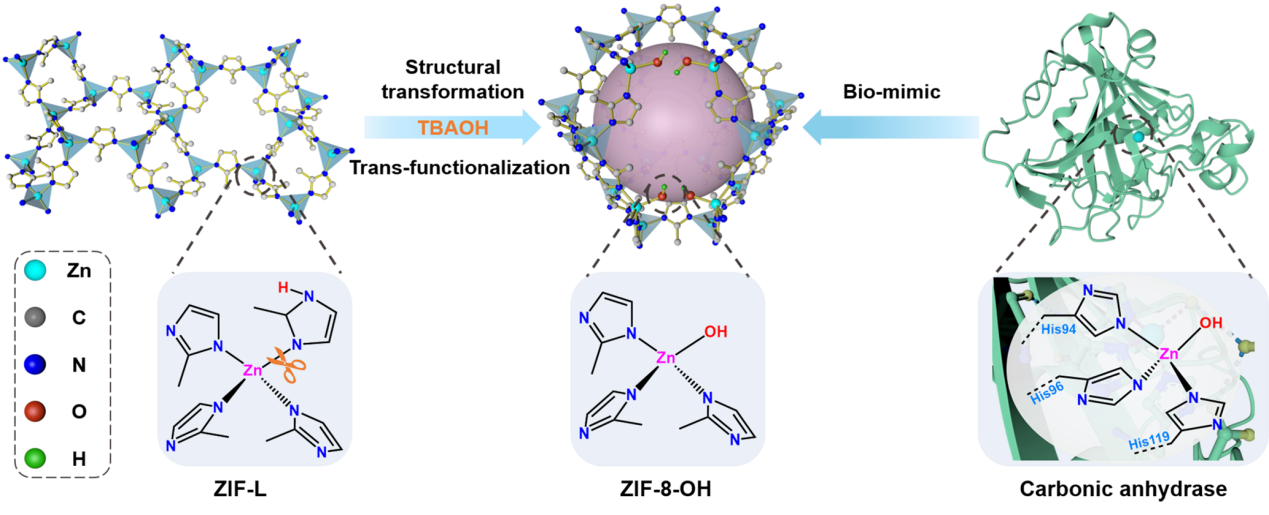
-
The Concerto of Transformation and Functionalization: The Leap of MOF Catalytic Function
2024-09-05
Just as the double-helix of DNA undergoes transformation to perpetuate life, and amoebas transform to achieve movement and energy intake, transformation is a fundamental force in nature that drives innovation and now it is inspiring chemists and material scientists to design and modify systems with optimized functionality.
In a groundbreaking development, scientists from Nanjing Tech University have integrated the processes of functionalization with structural transformation to create a novel methodological strategy named as trans-functionalization. This approach has successfully addressed the challenge of fabricating MOF-based enzyme-like catalysts with both an increased number of active sites and enhanced catalytic activity.
“Enzyme mimics offer promising avenues for overcoming the structural fragility of enzymes while maintaining their activity. Metal-organic frameworks (MOFs) have emerged as ideal platforms for constructing enzyme mimics due to their isolated metal nodes, structural diversity, and tunable pore environments, which can mimic both the coordination structure and microenvironment of enzyme channels.” said Prof. Fengwei Huo, who is the principal investigator of the laboratory. “Numerous metalloenzyme mimics have been successfully developed based on MOFs, garnering increasing attention.”
Leveraging the structural flexibility of MOFs, the team applied a transformation from ZIF-L to ZIF-8 to the create carbonic anhydrase (CA) mimics with significantly enhanced catalytic properties. Through detailed theoretical and experimental characterizations, the team highlighted the preferential functionalization of hydroxyl groups with interlayer Zn clusters in ZIF-L. This innovative strategy of functionalization through MOF structural transformation promises to inspire the development of more advanced enzyme mimics based on MOFs and enrich methodologies within material science.
The study was published on Jul.8th in Research, the first Science Partner Journal recently launched by the American Association for the Advancement of Science (AAAS) in collaboration with the China Association for Science and Technology (CAST). Huo is a professor of Key Laboratory of Flexible Electronics (KLOFE), Institute of Advanced Materials (IAM) & School of Flexible Electronics (Future Technologies), Nanjing Tech University.
“At present, two strategies are usually used to construct enzyme mimics based on MOFs. The first strategy is pre-functionalization where ligands with enzymic activity are directly used to synthesize MOFs. However, the usable enzymes were quite limited and the obtained active sites in this strategy are distributed inside the MOF framework and not easy to get contacted. The second strategy is post-functionalization. This method exhibits merits in its universality but the number of active sites is small and most of them are only generated on the outer surface of MOFs, leading to a low catalytic activity.” said Prof. Fengwei Huo. “Therefore, developing a preparation method of enzymatic mimics with high catalytic activity is quite valuable in the fields of academic research and industrialization.”
The concept of trans-functionalization overcomes these limitations. Unlike traditional methods that often result in a limited number of active sites, this new approach can graft more active sites and introduce a hierarchical porous structure, increasing the accessibility of the active centers. The lower reaction energy barrier and higher catalytic efficiency observed in ZIF-8-OH during para-nitrophenyl acetate (p-NPA) hydrolysis highlight the potential of this strategy to advance the field of biomimetic catalysis.
This work represents a significant leap forward in the development of highly efficient enzyme mimics within MOFs, opening new avenues for research and applications in various catalytic processes.
The study, titled “A Structural Mimic of Carbonic Anhydrase in Zeolitic Imidazolate Frameworks via Trans-functionalization for Enhancing Hydrolytic Activity” was supported by the National Natural Science Foundation of China (62288102, 22305116, 21908105, 21727808, and 21971114) and the Jiangsu Provincial Funds for Natural Science Foundation (BK20230308 and BK20200090). Dr. Fanchen Meng, the post-doctoral researcher of Huo’s group, served as the paper’s first author.
Original Source:
Fanchen Meng; Cheng Xu; Linghai Zhang; Xiaohan Huang; Xinglong Zhang; Wenlei Zhang; Yongqi Luo; Weina Zhang; Wei Huang*; Fengwei Huo*; Suoying Zhang*. A Structural Mimic of Carbonic Anhydrase in Zeolitic Imidazolate Frameworks via Trans-functionalization for Enhancing Hydrolytic Activity.
https://doi.org/10.34133/research.0434.

IMAGE: CARBONIC ANHYDRASE MIMIC (ZIF-8-OH) CONSTRUCTED BY TRANS-FUNCTIONALIZATION DURING THE STRUCTUAL TRANSFORMATION FROM ZIF-L TO ZIF-8.
Tag: Advanced Materials